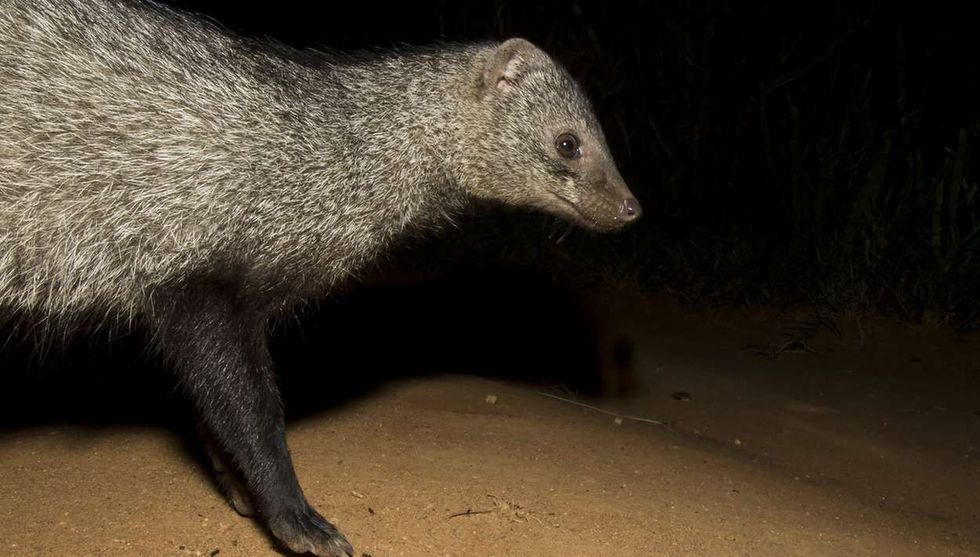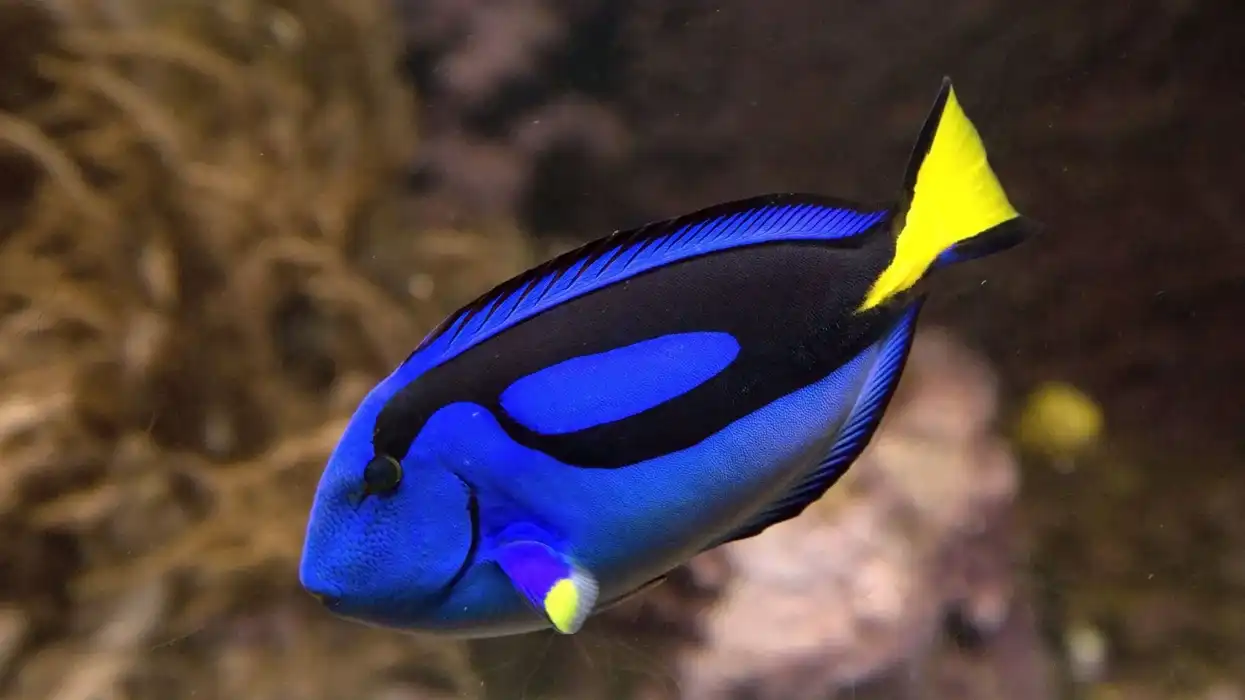A member of the Herpestidae family, genus Ichneumia, the white-tailed mongoose (Ichneumia albicauda) is the largest mongoose species in the entire mongoose family. The species name, or more specifically, the white-tailed mongoose's scientific name, Ichneumia albicauda, has been derived from Latin and Greek.
In Latin, the term 'albus' implies white, while 'cauda' refers to tail. On the other hand, the Greek term 'ichneumon' suggests tracker.
These mongooses are unique for their long and bushy white-tipped tails. Did you know the species has a special gait? It's trotting!
The white-tailed mongoose in Africa is captured and slaughtered on a large scale by hunters who benefit from selling off their meat and fur in the local markets. The main predator of the species is native human hunters in Africa.
Kruger National Park is a reserve for a variety of animals including several species of mongooses. However, the white-tailed mongoose is a rare sight in Kruger safaris.
Here are some intriguing facts about the white-tailed mongoose. To be more aware of other animal species, take a look into some more amusing facts about the takin and the clouded leopard.
White-Tailed Mongoose Interesting Facts
What type of animal is a White-Tailed Mongoose?
A white-tailed mongoose (Ichneumia albicauda) is a mongoose. Among the two subfamilies of the mongoose species (namely Herpestinae and Mungotinae), the white-tailed mongoose belongs to the Herpestidae family.
What class of animal does a White-Tailed Mongoose belong to?
The white-tailed mongoose comes under the class Mammalia.
How many White-Tailed Mongooses are there in the world?
The exact number of white-tailed mongooses prevalent in the entire world cannot be stated due to insufficient records. However, as per the records of the International Union for Conservation of Nature (IUCN) Red List, the population density of the species is quite high. You can easily locate one if you visit the Cape Province of Africa.
Where does a White-Tailed Mongoose live?
This mongoose species is rampant in the southeastern parts of South Africa as well as sub-Saharan Africa and the southern regions of the Arabian peninsula. A large number of white-tailed mongooses are also found in the coastal belt of Saudi Arabia, Oman, and Farasan Kabir Island. They can also be found in parts of Ethiopia.
What is a White-Tailed Mongoose's habitat?
The habitat of the species is wide-ranging as they can be found in diverse environments that include shrublands, forests, grasslands, savannahs, and wetlands. The species is common in woodland areas and semi-desert regions but they are not very well suited to completely dry, arid places or areas with high moisture such as swamps, marshes, or rainforests.
Who do White-Tailed Mongooses live with?
The social behavior of these animals varies - some are known to dwell alone, while others form small clans and live with other mongooses (outside the breeding period). A group of Mongooses is collectively called a mob or a pack.
How long does a White-Tailed Mongoose live?
On average, the life span of a white-tailed mongoose ranges from 10-12 years.
How do they reproduce?
Mongooses are polygynous, whereby the males mate with multiple females. Specific data about the mating cycle of the white-tailed mongoose is deficient.
However, the mating season normally falls between December and March and the occurrence of litters has been recorded mostly in the wet season between February and May and sparsely in the dry season. During copulation, the male mongoose mounts on top of the female in succession.
There are no scientific records about the gestation period. Generally, a female gives birth to 1-3 pups and weaning takes place at about nine months from birth.
What is their conservation status?
As per the computations of the International Union for Conservation of Nature or the IUCN Red List, the species of white-tailed mongoose is of Least Concern. Their population is pretty widespread within their geographical habitat.
White-Tailed Mongoose Fun Facts
What do White-Tailed Mongooses look like?

*We've been unable to source an image of a White-Tailed Mongoose and have used an image of its habitat. If you can provide us with a royalty-free image of a White-Tailed Mongoose, we would be happy to credit you. Please contact us at hello@kidadl.com.
The primary color of their coat ranges between the shades of gray and gray-brown. The fur around their hindquarters and tail is longer and thicker. The length of its tail is about 18.5 in (47 cm). They possess long black and white guard hairs and a white tail.
Each foot consists of five toes with curling claws at the tip. Both the males and females possess two sets of mammae. The white-tailed mongoose has bilateral symmetry.
How cute are they?
Mongooses are furry and cute animals but the cuteness quotient largely depends upon individualistic perspectives. Some consider these small-sized animals cute while few others frown with disgust. However, a tiny young white-tailed mongoose is overloaded with cuteness.
How do they communicate?
Apart from vocalizations, these creatures use olfactory senses to communicate. Mainly urine and dung smells are used for this purpose while vocalizations include barking, growling, and whimpering.
How big is a White-Tailed Mongoose?
The average body length of the white-tailed mongoose is about 19-28 in (48-71 cm). They are almost twice the size of the dwarf mongoose, which has a length of about 7-11 in (18-28 cm).
How fast can a White-Tailed Mongoose run?
Mongooses are thrifty little animals known for their swift reflexes and ninja-like movements. They can reach an average speed of approximately 20 mph (32 kph).
How much does a White-Tailed Mongoose weigh?
These animals have negligible weight with an average body mass of 6.3-9.3 lb (2.9-4.2 kg) that reaches up to a maximum range of 11 lb (5 kg). The weights of the males and females have little difference. While the weight of a male is generally around 8 lb (3.6 kg), a female weighs about 7 lb (3.4 kg).
What are the male and female names of the species?
There are no sex-specific names for males and females.
What would you call a baby White-Tailed Mongoose?
A baby mongoose is commonly regarded as a pup while a group of young pups is called a litter.
What do they eat?
White-tailed mongooses are omnivorous but their diet depends to a certain extent on the available food source. Food items in their diet primarily include small insects, snakes, birds, amphibians, rodents, and others.
However, their diet also comprises seasonal fruits and berries while they also feed on dung beetle and their larvae (in wet seasons) and termites (in dry seasons).
In human areas, they can also gobble eggs extracted from garbage bins. For this, they toss the eggs and place them carefully between their hind legs crushing them against solid surfaces to feed on the contents of the eggs.
Are they poisonous?
Although these animals might be harmless and non-venomous, their bites can prove to be harmful as they can cause streptococcal sepsis in humans.
Would they make a good pet?
Mongooses can prove to be great household pets if they are reared and trained well from a young age. Preferably the species must not be reared in captivity since they are creatures of forests and woodlands and must not be removed from their natural abode just to be brought up as comforting pets.
Did you know...
Did you know that white-tailed mongooses are mainly nocturnal? They are mostly active during the nighttime, especially when the sky is overcast with dark clouds.
White-tailed mongooses are sedentary, that is, they prefer to remain in a relaxing seated position for most of the time.
White-tailed mongooses are ground dwellers. They construct their den in depressions near trees or evacuated termite mounds.
It is believed that both sexes engage in scent-marking by urinating. This helps them to make other mongooses aware of their occupancy of areas.
Are White-Tailed Mongeese dangerous?
Although mongooses are popular for their showdowns with venomous and deadly snakes, they portray little to no aggressive behavior in human surroundings. They normally do not attack humans or other animals unless they feel threatened. Some families rear mongooses for their friendly and trainable nature.
What is the difference between a White-Tailed Mongoose and a regular Mongoose?
According to assessments of the African Journal of Ecology, the social organization of the white-tailed mongoose resembles that of solitary mongooses as both belong to the mongoose family. The ranges of the males and females overlap.
In appearance, the white-tailed mongoose can be distinguished from the regular mongoose by its white-tipped tail and large size. Some differences in behavioral patterns can also be noticed. For instance, regular mongooses engage in digging burrows while white-tailed mongooses dwell in dens. However, their diets and predatory instincts are similar.
Here at Kidadl, we have carefully created lots of interesting family-friendly animal facts for everyone to discover! Learn more about some other mammals including Sri Lankan elephant facts and Wolamute facts.
You can even occupy yourself at home by coloring in one of our free printable mongoose coloring pages.










